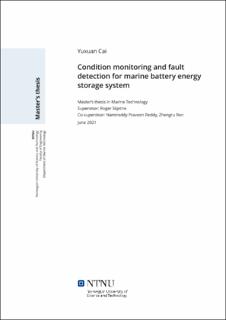| dc.description.abstract | Battery energy storage system (BESS) is widely applied in hybrid-electric and all-electric power and propulsion solutions to reduce fuel consumption and emissions in ships. To achieve optimal performance, it is necessary to estimate and monitor the conditions of the BESS, such as state-of-charge (SOC) and state-of-health (SOH). Moreover, to ensure a safe operation, the failure of batteries should be predicted, and the faults in a BESS should be detected and handled.
This thesis focuses on a model-based and data-driven-based method for both condition monitoring and fault detection. Due to the lack of available datasets in the marine industry, two public Li-ion battery datasets from the electric vehicle industry are adopted. It should be noted that the obtained results would be equally applicable in the marine industry. The short-term drive cycle performance dataset is used for: a) SOC estimation with extended Kalman filter (EKF) and recurrent neural networks (RNN) with long short-term memory (LSTM), b) power limit estimation with hybrid power pulse characterization (HPPC), and c) voltage sensor fault detection. The long-term degradation dataset is used for a) SOH estimation and b) remaining useful life (RUL) prediction.
For SOC estimation, the EKF achieved a mean absolute error (MAE) of 0.32%, while the LSTM-RNN, which used current and voltage as input features, had an MAE of 0.84%. For power limit estimation, the HPPC method showcased how power limit can be determined based on SOC and terminal voltage. For SOH estimation and RUL prediction, the LSTM-RNN, which used cycle number and features of the incremental capacity (IC) analysis as input features, achieved an MAE of 0.62% in SOH estimation and 64.7 cycles in RUL estimation. For fault detection, the generalized likelihood ratio (GLR) algorithm provides a systematic approach for residual analysis. Test results showed that the GLR decision function is capable of detecting voltage sensor faults with a short time delay of 0.3s. | |
